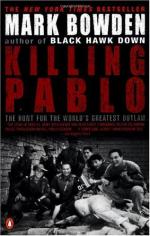|
This section contains 545 words (approx. 2 pages at 400 words per page) |

|
Killing Pablo: The Hunt for the World's Greatest Outlaw Summary & Study Guide Description
Killing Pablo: The Hunt for the World's Greatest Outlaw Summary & Study Guide includes comprehensive information and analysis to help you understand the book. This study guide contains the following sections:
This detailed literature summary also contains Topics for Discussion and a Free Quiz on Killing Pablo: The Hunt for the World's Greatest Outlaw by Mark Bowden.
Pablo Emilio Escobar Gaviria was a Colombian national who rose to infamy through his exploits as the leader of the notorious Medellin Drug Cartel, a seemingly unstoppable force in the underworld into the 1990s. It took more than $700 million dollars and over 7 years to stop Escobar, with countless numbers of lives ruined or lost.
"Killing Pablo: The Hunt for the World's Greatest Outlaw" by Mark Bowden details the life of Pablo Escobar as well as the political climate of Colombia and how it allowed Escobar to become a legendary criminal and philanthropist.
Escobar was born in 1949 to Abel de Jesus Escobar, a successful cattle farmer, and Hermilda Gaviria, a well educated and capable school teacher. Pablo was the third of seven children for the Escobars. The family lived in Rionegro, a town in which violence and death were common.
Bowden discusses the politics of Colombia as they were an integral part in the making of Escobar. The country was wildly unstable and its government was shaky at best. For a time there was a hope that the small, poor country would be a part of something bigger, more democratic and powerful.
Colombia's political future seemed to rest in the hands of Jorge Eliécer Gaitán. Gaitán was a lawyer and socialist that soon became so well loved that he won the Liberal Party's nomination for the presidency.
As Gaitán continued to fight for the unheard voices of Colombia, he also made some very powerful enemies. When Gaitán was assassinated in 1948, the death of a beloved leader set off Bogotazo, a bloody massacre that would lead to La Violencia, an era of civil unrest and violence that would last for a decade.
Pablo Escobar grew up in this climate, which clearly affected his personality and ambitions. Escobar idolized criminals like Jesse James and Bonnie and Clyde along with Colombian outlaws such as Sangrenegra and Desquite.
Escobar was young when he began his criminal career. Escobar began with car theft and quickly moved into the drug arena. As the years went on, Escobar's exploits encouraged swift and deadly violence which escalated as years went by. No one was safe from Escobar's wrath if the person stood in the way of the man's plans. While Escobar built his massive empire he also exercised a social conscience. On one hand, Escobar was a ruthless murderer. On the other, the man was devoted to protecting the poor of the country, determined that no child would ever starve and that the people of Colombia would have every advantage possible. Escobar's philanthropy and generosity made him incredibly popular and powerful.
Escobar eventually became the seventh richest man in the world and as a criminal, virtually untouchable.
Bowden examines in detail the massive manhunt designed to take down Escobar and the Medellin drug cartel. The number of people and organizations involved in the manhunt was massive and included guerillas, vigilantes, drug traffickers, law enforcement officials, and politicians from Colombia and the United States. The author relays the insight of key players like Colonel Hugo Martinez, the man put in charge of Search Bloc, the organization that would eventually put an end to Escobar's reign.
Pablo Escobar was shot and killed by US DEA agents in 1993.
Read more from the Study Guide
|
This section contains 545 words (approx. 2 pages at 400 words per page) |

|



